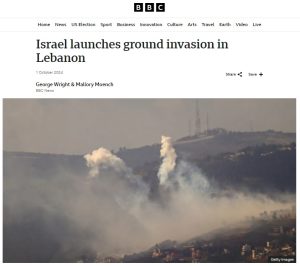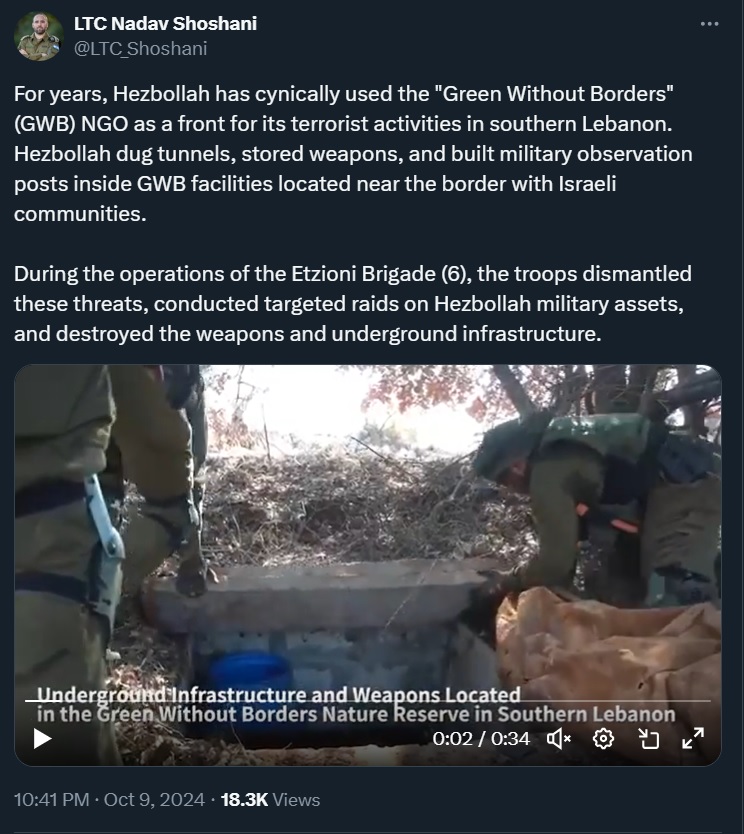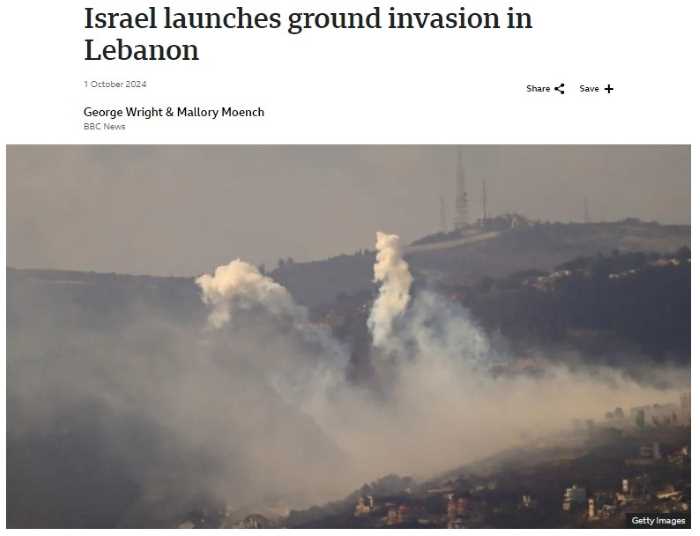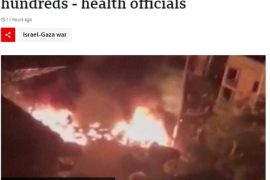As readers may have already noticed, the BBC’s abundant coverage of events in Lebanon during the past couple of weeks since IDF forces began limited ground operations has not included much reporting on the topic of Hizballah assets found in the border region either during or before those operations began.
As the ground operations commenced, the IDF announced that it had already carried out operations to dismantle Hizballah infrastructure, including tunnels.
“The Israel Defense Forces revealed Tuesday that even before it officially launched ground operations in southern Lebanon earlier in the day, its troops had conducted dozens of secret cross-border raids throughout the current war, destroying numerous Hezbollah positions, tunnels and sites.
The army also disclosed that days after Hamas’s October 7 mass onslaught in southern Israel, thousands of terrorists had been positioned near the Lebanon border in a plan to storm the Galilee and unleash similar carnage there.
The IDF briefed reporters on the new information before IDF Spokesperson Rear Adm. Daniel Hagari held a briefing in Hebrew and in English, presenting images and maps from the foiled mass invasion plan and elaborating on the subsequent covert commando missions in southern Lebanon, which aided the military campaign to dismantle the immediate threat and drive Hezbollah away from the border. […]
The military showed reporters dozens of weapons recovered by the commandos from within Hezbollah tunnels and bunkers, including assault rifles, machine guns, RPGs, anti-tank missiles, explosive devices, mines, mortars, and equipment such as walkie-talkies…”
Among the reporters at that briefing was the BBC’s Lucy Williamson, as can be seen from 07:32 in this BBC News Channel report about what she describes as “Israel’s wars” from October 1st.
However in most of the BBC’s “permanent public record” reports published on its website, audiences found only vague references – if at all – to Hizballah assets discovered before or since the ground operations began and, notably, no pictures whatsoever – including in Williamson’s own reporting. [emphasis added]
“How Israel-Hezbollah conflict escalated to a ground invasion”, 1/10/24, David Gritten
“Israel launches ground invasion in Lebanon”, 1/10/24, George Wright & Mallory Moench
“According to the Israel Defense Forces (IDF), the operation is aimed at the Iran-backed group’s “infrastructure”, which it says poses “an immediate threat to Israeli communities in northern Israel”. […]
The Lebanese armed group – which is proscribed as a terrorist organisation by the US, UK and other countries – is known to have extensive tunnel networks as well as bunkers and other military infrastructure just over the border from Israel.”
“‘The country is lost’: Fear and uncertainty in Lebanon as Israel invades”, 1/10/24, Hugo Bachega
“Tanks and jets on the move at Israel-Lebanon border”, 1/10/24, Lucy Williamson
“Eight Israeli troops killed in fighting with Hezbollah inside Lebanon”, 3/10/24, Hugo Bachega & David Gritten
“Earlier, the Israeli military announced that more infantry and armoured troops had joined the operation seeking to dismantle what it called “terrorist infrastructure” in Lebanese border villages. […]
Hezbollah has spent years building infrastructure in southern Lebanon that includes extensive underground tunnels. It also has thousands of fighters, who know the area well.”
“Anger and grief in south Lebanon city almost deserted after Israeli strikes”, 5/10/24, Orla Guerin
“Israel-Hezbollah conflict in maps: Where is fighting happening in Lebanon?”, updated 4/10/24, Visual Journalism team
“The Israel Defense Forces (IDF) has said it is carrying out “limited, localised, and targeted ground raids” in southern Lebanon to dismantle what it calls Hezbollah’s “terrorist infrastructure”. […]
Hezbollah is also thought to have a network of tunnels in the region, with the group having been preparing for another full-scale conflict with Israel since the 34-day war in 2006. […]
Israel’s invasion of southern Lebanon came after nearly two weeks of intense air strikes that Israel’s military says target Hezbollah in the south of the country, the eastern Bekaa Valley and the southern suburbs of Beirut.
Israel says it is hitting Hezbollah sites, including weapons stores and ammunition dumps, but Lebanese officials say more than 100 women and children have been killed.”
“Israeli strike kills 10 firefighters in south Lebanon, authorities say”, 7/10/24, David Gritten
“The Israeli invasion of southern Lebanon also appeared to be expanding, with the IDF saying that a third division had joined the ground operation it launched six days ago to dismantle Hezbollah infrastructure near the border.”
“Netanyahu warns Lebanon of ‘destruction like Gaza’”, 8/10/24, David Gritten & Thomas Mackintosh
“On Tuesday morning, the IDF announced that reservists from its 146th Division had begun “limited, localized, targeted operational activities” in south-western Lebanon.
It joined three standing army divisions which have been operating in central and eastern areas of southern Lebanon since the invasion began on 30 September – reportedly bringing the total number of soldiers deployed to over 15,000.
The IDF said troops had taken control of what it called a Hezbollah “combat compound” in the border village of Maroun al-Ras and published photos showing what it said was a loaded rocket launcher in an olive grove, as well as weapons and equipment inside a residential building.”
Notably, BBC audiences do not see that photograph in Gritten and Mackintosh’s report. The IDF has published numerous statements including photographs and videos of weaponry and other military assets, including tunnels, found in southern Lebanon in the past couple of weeks but remarkably, those photographs and videos have not been used to explain to BBC News website readers what Israel’s ground operation entails.
Among the documentation provided by the IDF is video of underground infrastructure and weapons found in a nature reserve run by the ‘environmental NGO’ called ‘Green Without Borders’.

That discovery would not come as much of a surprise to anyone familiar with the US designated NGO that was described by WINEP in 2020 as:
“…a Hezbollah front, providing the militant group cover for operational activities prohibited under UN Security Council Resolutions 1559 and 1701—from conducting preoperational surveillance to firing rockets at Israel.”
However, as CAMERA UK has repeatedly documented over the past seven years, the BBC has never produced any coverage whatsoever informing its audiences of the activities of that Hizballah-linked organisation.
On the evening of October 12th – twelve days into the ground operations – the BBC News website published a report by Lucy Williamson titled “Inside Israel’s combat zone in southern Lebanon”. That article includes the first proper account presented to BBC News website audiences concerning Hizballah assets that the IDF has discovered in southern Lebanon.
“We were also shown three caches of weapons it said were found inside civilian homes here, including boxes of brand-new mortars, new anti-tank missiles and mines, as well as sophisticated shoulder launched rockets and night-scopes.
One anti-tank missile we saw was already semi-assembled.
The chief of staff for the 91st Division, Roy Russo, also showed us a garage he said had been used as an equipment warehouse, with sleeping bags, body armour, rifles and ammunition hidden in a large barrel.
“This is what we call an exchange zone,” he said. “They’re morphing from civilians into combatants. All this gear is designed to manoeuvre into [Israel] and conduct operations on the Israeli side. This is not defensive equipment.”
This, Israel says, is why it launched its invasion of southern Lebanon; that Hezbollah’s stockpiles of weapons and equipment along this border were planning for a cross-border attack similar to last year’s 7 October attacks by Hamas in southern Israel.
At the start of this invasion, the army revealed that Israeli special forces had been operating across the Lebanese border in small tactical units for almost a year, conducting more than 70 raids to find and destroy Hezbollah infrastructure, including underground tunnels – one of which, it said, stopped 30m (100ft) before the ceasefire line with Israel and was unfinished.
Col Malka showed me some of the weapons he said the army found on the day we arrived. They include a large IED, an anti-personnel mine, and a high-tech night-scope.
He said troops were finding “two to three times” the number of weapons they found in Gaza, with “thousands” of weapons and thousands of pieces of ammunition found in this village alone.”
The article also includes a three-and-a-half-minute long filmed report about Williamson’s visit to southern Lebanon in which viewers see around 21 seconds of footage of weapons and military equipment found in that particular village.
The BBC cannot meet its obligation to provide audiences with accurate and impartial information which will contribute to their understanding of current events in southern Lebanon so long as it minimises the documentation of weapons found in homes and on streets, command centres in mosques and other public buildings or tunnels in nature reserves or ostensibly civilian homes. Williamson’s documentation is long overdue and the question that arises is why it took the BBC twelve days to report on this topic.
Related Articles:






So far too long, probably 30 years, the BBC has DELIBERATELY, missed out key information to present a jaundiced view.
One can recollected that their ace BBC Radio 4 reporters of the 1990’s on the 8am News used to paint their pictures by excluding key information with respect to Israel.
Nothing changes in the BBC University of Journalism